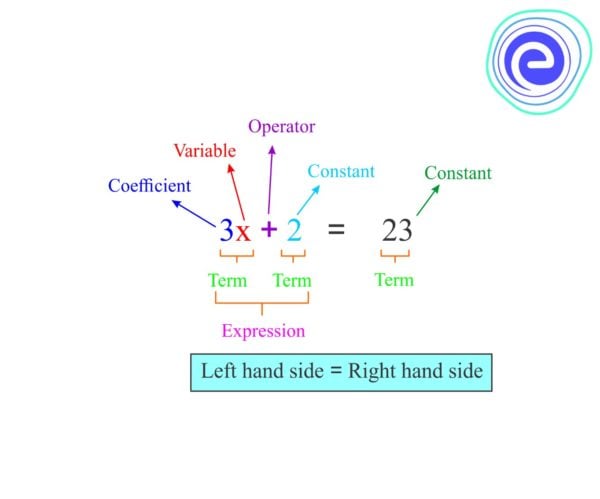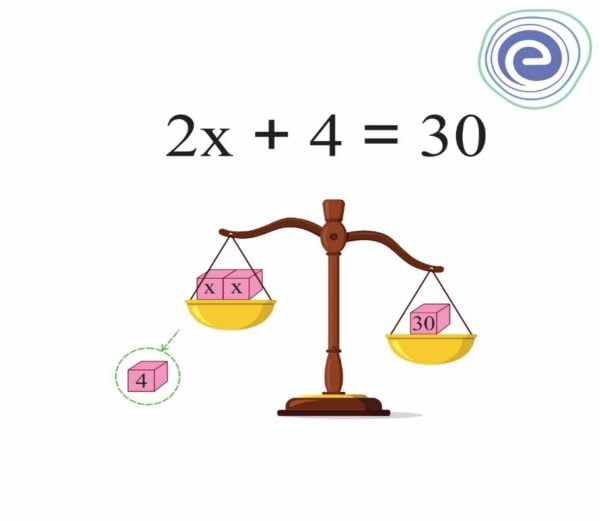- Written By
Madhurima Das
- Last Modified 22-06-2023
Simple Equations: Variables, Properties, Examples
Simple Equations: The concept of an equation in Algebra closely resembles the concept of balancing. An equation can consist of variables, constants, or equality sign the equals sign (=) can be regarded as the fulcrum or centre when solving a simple equation. Therefore, if you change one part of the equation, you must also change the other part. Balance is maintained by adding the same amount to both sides of the equation (say, 7 to each side).
In a weight balance instrument, the working principle of the equality symbol is the same as that of the balance scale. A simple equation is considered a linear equation in one variable. That means it involves a polynomial of degree one and with one variable only. Solving a simple equation means we find out the value of the unknown variable. In this article, you will find the simple equation definition and study the different methods to solve them.
Simple Equation Definition: Variables
A variable is a quantity that may change with the context of a Mathematical problem. When a variable is used in an algebraic expression, it is known that it is not a constant number, but it can represent many numbers. Alphabets like \(x,\,y,\,z\) are the generic type of variables and are used most of the time, but at times we will choose a letter that reminds us of the quantity it represents, such as \(v\) for velocity, \(t\) for time, \(s\) for speed, \(d\) for distance, etc.
Simple Quadratic Equation: Algebraic Expression
A combination of constants and variables connected by a sign of fundamental operations of addition, subtraction, multiplication, and division is called an algebraic expression.
For example, \(x\, + \,2y,\,a + 3b + c,2{x^2}\, + \,5,\) etc., are the algebraic expressions.
What are Simple Math Equations?
In short, an equation is a condition on a variable such that the two expressions should have equal values. Note that at least one of the two expressions must contain the variable.
An equation remains the same when the expressions on the left and the right are interchanged.
For example, \(x\, + \,2y\, = 0,a + 3b + c = 0,2{x^2}\, + \,5 = 0\) are the equations.
Simple Linear Equations
An equation in which the highest power of the variables involved is one is called a linear equation. A linear equation can include different variables. When it consists of two different variables, it is known as a linear equation in two variables. If it consists of three variables, it is known as a linear equation in three variables and so on.
For example,
Linear equation in one variable, \(3x + 2 = 9,x = 7\)
Linear equation in two variables, \(x\, + \,2y = 0\)
Linear equation in three variables, \(a\, + 3b + c = 0\)
Simple Equation
A linear equation that involves only one variable is known as a simple equation or a linear equation in one variable.
For example, \(3x + 2 = 23,x = 7,2x + 6 = 3x – 4,\)etc., are simple equations.
Methods to Solve Simple Equations
We can solve a simple equation using three methods. The methods are,
- Trial and error method
- Systematic method
- Transposition Method
Trial and Error Method
In this method, we guess a solution to the equation. We find the values of LHS and RHS of the given equation for different values of the variable. The value of the variable for which \({\rm{LHS = RHS}}\) is the solution of the equation.
Let us take an example \(x + 7\, = \,10\)
We have \({\rm{LHS}}\, = x + 7\, = \,10\) and \({\rm{RHS}} = 10.\)
Therefore, \({\rm{LHS}}\,{\rm{ = }}\,{\rm{RHS}}\) for \({\rm{x}}\,{\rm{ = }}\,{\rm{3}}\)
Systematic Method
An equation can be compared with a weighting balance. The two sides of an equation are two pans, and the equality sign tells us that two pans are balanced. If equal weights are put in two pans, then two pans will be balanced. If we remove or add equal weights to both the pans, then we can still see the pans are in balance.
Let us take some simple equations examples,
Equation Involving Addition
\(x – 7 = 6\)
Then, adding \(7\) on both sides, we have \({\rm{x}}\, – 7 + 7 = 6 + 7\)
Therefore, \(x = 13\)
Equation Involving Subtraction
\(x + 3 = 5\)
Then, subtracting \(3\) on both sides, we have \(x + 3 – 3 = 5 – 3\)
Therefore, \(x = 2,\)
Equation Involving Division
\(15x = 45\)
Then dividing by \(15\) on both sides we have,
\(\frac{{15x}}{{15}} = \frac{{45}}{{15}}\)
Therefore, \(x = 3\)
Equation Involving More Than One Rule
\(3x\, + 2 = 5\)
Subtracting \(2\) from both the sides we have,
\(3x + 2 – 2 = 5 – 2 \Rightarrow 3x = 3\)
Dividing by \(3\) both sides we get, \(\frac{{3x}}{3} = \frac{3}{3}\)
Therefore, \(x = \,1\)
Transposition Method
In this method, any term of an equation is taken to the other side with its sign changed without affecting the equality. When we shift one term of an equation from LHS to RHS or vice versa, the plus sign of the shifted term change into a minus sign, and a minus sign changes into a plus sign.
For example, \(3(x – 1) = 2x – 11\)
Expanding the brackets in \({\rm{LHS}}\) , we have, \(3x – 3 = 2x – 11\)
Now, transposing \(3\) from \({\rm{LHS}}\) to \({\rm{RHS}}\), we have, \(3x = 2x – 11 + 3\)
Transposing \(2x\) from \({\rm{RHS}}\), we get, \(3x\, – 2x = – 8\)
Hence, \(x = – 8\)
We now know how to solve a simple equation. Let us see how we will form a simple equation using the solution. For example,
Given solution, \(x = 5\)
Add \(3\) on both sides,
\( \Rightarrow x + 3 = 5 + 3\)
Multiply \(4\) on both sides,
\( \Rightarrow 4(x + 3) = 4 \times 8\)
\( \Rightarrow 4x + 12 = 48\)
Similarly, more equations can be formed.
Application of Simple Equations in Real-life
The value of an unknown quantity can be determined if a simple equation can be formed using the information related to the unknown quantity. The unknown quantity can be considered as \(x\) or any other variable such as \(a,\,b,\,c,\,d\) so on. The procedure to form an equation from a real-life problem using the given information (known and unknown quantities) is known as the formulation of the problem. Thus, the process of solving a real-life problem has two parts such as formulation and solution.
For example, \(6\) added to a number gives a number \(6\). Find the number.
Here, the number that we want to find is an unknown quantity.
\(6\) and \(10\) are known quantities that are related to the unknown quantity.
Let us assume the number (unknown quantity) as \(x\).
According to the statement, \(x\, + 6 = 10\)
Now, subtracting \(6\) from both sides we have,
\(x\, + 6 – 6\,\, = 10 – 6 \Rightarrow x = 4\)
Hence, the unknown number is \(4\)
Solved Examples – Simple Equations
Q.1: Solve the equation \(2x + 9 = 19\)
Ans: The given equation is \(2x + 9 = 19\)
Transpose \(9\) to \({\rm{RHS}}\)
\( \Rightarrow 2x\, = 19 – 9\)
\( \Rightarrow 2x\, = 10\)
Now, divide both sides by \(2\)
\( \Rightarrow \frac{{2x}}{2} = \frac{{10}}{2}\)
\( \Rightarrow x\,\, = \,5\)
Hence, the solution of equation \(2x\, + \,9\, = 19\) is \(x = \,5\)
Q.2: Solve the equation \(x – 4\, = \,0\) using the trial and error method.
Ans:
Hence, the solution of the equation \(x – 4\, = \,0\) is \(x\,\, = \,\,4\)
Q.3: The sum of two consecutive even numbers is \(86\) Find the numbers.
Ans: Let us consider the consecutive even numbers as \(x\) and \(x + 2\).
Given that the sum of two consecutive even numbers is \(86\).
\( \Rightarrow x + (x + 2) = 86\)
\( \Rightarrow x + x + 2 = 86\)
Transposing \(2\) from LHS to RHS, we get
\( \Rightarrow 2x + 86 – 2\)
\( \Rightarrow 2x = 84\)
Dividing both sides by \(2\) we get
\( \Rightarrow \frac{{2x}}{2} = \frac{{84}}{2}\)
\( \Rightarrow x = 42\)
Hence, the two consecutive numbers are \(42\) and \(44\).
Q.4: Priya’s father is three times as old as Priya. Suppose the sum of their ages is \(56\) years. Find their ages.
Ans: Let us say Priya’s age is \(x\) years.
Priya’s father’s age is \(3x\) years.
According to the given statement,
\(3x + x\, = 56\)
\( \Rightarrow 4x = 56\)
\( \Rightarrow \frac{{4x}}{4} = \frac{{56}}{4}\)
\( \Rightarrow x\, = 14\)
Priya’s age is \(14\) years, and her father’s age is \(3 \times 14 = 42\) years.
Q.5: The difference between the two numbers is \(7\). The sum of the six times the smaller and the larger is \(77\). Find the numbers.
Ans: Given that the difference between two numbers is \(7\) Let us say the smaller number is \(x\) and the larger one is \(x\, + 7\).
Now, the six times of the smaller number is \(6x\)
According to the given statement,
\(6x\, + (x + 7) = 77\)
\( \Rightarrow 6x\, + x + 7 = 77\)(expanding the brackets in LHS)
\( \Rightarrow 7x\, = 77 – 7\) (transposing \(7\) from LHS to RHS)
\( \Rightarrow 7x\, = 70\)
\( \Rightarrow \frac{{7x}}{7}\, = \frac{{70}}{7}\)
\( \Rightarrow x = 10\)
Therefore, the smaller number is \(x = 10\) and the larger number is \(x + 7 = 10 + 7 = 17\)
Students can take Simple Equations notes from the solved examples to revise the concept quickly.
Simple Equations: Summary
In this article, we have learned about simple equations and the methods for solving them, such as trial and error, systematic, and transposing methods. In addition, we discussed the application of simple equations in real life.
FAQs About Simple Equations Class 7
Some of the frequently asked questions about Simple Equations are mentioned below:
Q.1: How do you solve simple equations?
Ans: When a simple equation is given, we will keep the variable terms on the left side of the equal sign and the constant terms on the right side using the systematic method or transposing method. Then we will find the unknown variable.
Q.2: Explain the simple equations using examples.
Ans: A linear equation that involves only one variable is known as a simple equation or a linear equation in one variable.
For example, \(x + 5 = 4,2x – 6 = 8x + 2,\) etc., are simple equations.
Q.3: What are the \(3\) methods for solving the simple equations?
Ans: The three methods for solving simple equations are,
1. Trial and error method
2. Systematic method
3. Transposition Method
Q.4: What is an Algebraic Expression?
Ans: A combination of constants and variables connected by a sign of fundamental operations of addition, subtraction, multiplication, and division is called an algebraic expression.
For example, \(x\, + \,2y,\,a + 3b + c,2{x^2}\, + \,5,\) etc., are the algebraic expressions.
Q.5: Give three real-life examples of simple equations.
Ans: We use simple equations,
1. Problems based on ages
2. Problems based on finding unknown numbers
3. Problems based on profit and loss
Q.6: How do you write equations?
Ans: In an equation, there is always an equality sign. The equality sign shows that the value of the expression to its left is equal to the value of the expression to its right. So we can write an equation using variables and algebraic expressions with an equality sign.
We hope this detailed article on simple equations has helped you in your studies. If you have any doubts or queries, you can ask us in the comment section below. Happy learning!












































